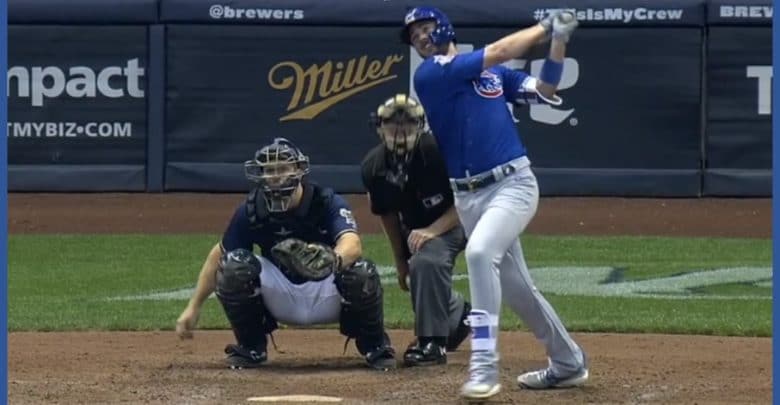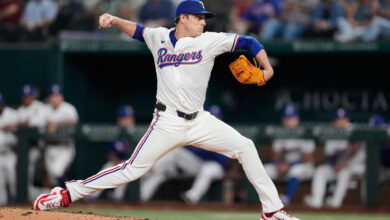
Eliminating Shift Might Benefit Cubs More than Other Teams
Among the many hills Rob Manfred has offered to die on since taking over as commissioner, eliminating the shift may be the tallest. Or maybe it’s the shortest, just depends on how you want to work the metaphor. While it’s been at the top of his list for a while, there seems to be enough momentum from both sides to enact a change with relative ease.
Jayson Stark examined all the rationale behind the elimination of the shift, including its potential impact on offense, in a comprehensive piece for The Athletic (subscription). And while the noted reduction in MLB offense across the board isn’t just a product of Big Shift, it does offer an even more convenient scapegoat than Cubs hitting and pitching coaches.
Consider that there were 3,000 fewer singles in 2018 than 10 years ago, or that 517 balls hit into the shift would have been hits against a standard defensive alignment. Lefty power hitters face the shift most often, especially when they don’t have a ton of speed and aren’t beating out many grounders. You can read about all that and more in Stark’s piece, but I’d like to turn away from the general stuff now to talk about how the Cubs might be impacted.
Given their analytical bent and the high intelligence of the leaders involved, it figures that they’d be able to adjust quickly. More important than the aptitude to change, however, is the attitude.
“I’m at the point now where whatever MLB wants to do, or attempt to do, on different things, I’m going to be on board,” Joe Maddon told Stark. “I did watch maybe an inning or two of the postseason, and I totally understood what they were talking about, how slow everything was. The pace was very, very slow. And now I get it. We’ve been involved with the playoffs the last three years, four years, and I was not able to watch all this. So now I saw it. Now I get it.”
Of course, it helps that the Cubs employed the shift on only 5.1 percent of plate appearances against them in 2018, less often than all but two teams (Cardinals – 4.4, Angels – 3.4). That’s less than one-third of the league average (17.4), similar to the disparity between their shifts against lefties (10.1) and league average there (29.6). All of which is to say the Cubs would not need to make significant strategic changes.
The Brewers, on the other hand, used the shift an NL-high 23 percent of the time and could have a tougher time adjusting. The numbers aren’t nearly as high for the Pirates (14.2) or Reds (9.5) and we’ve already established how little the Cards shift, so changing the rules might not result in any dramatic advantages for the Cubs from a defensive perspective.
The other side of that coin, however, is that Cubs hitters might face significantly less impediment when it comes to BABIP. Remember that whole thing about lefty hitters who aren’t really too fleet of foot? Well the Cubs just so happen to have a pair of them occupying key roles in the lineup. Kyle Schwarber faced a shift on 64.6 percent of his plate appearances, Anthony Rizzo on 62.3 percent of his. League-average against lefties last year: 29.6 percent.
Since lefties see the shift far more often than their counterparts with uglier swings, Schwarber (29) and Rizzo (31) hold the same ranks among all hitters as they do among lefties. In fact, a righty doesn’t appear on the list until Edwin Encarnacion at No. 40 with 55.3 percent. Kris Bryant is sixth among righties (67th overall) at 43.2 percent, and that’s actually way down from the 54.8 percent he was seeing through mid-May.
Hey wait, what happened around that time that might have precipitated a change in the way Bryant was pitched? The linked article above was published on May 16, just three days before an ill-fated headfirst slide jammed Bryant’s shoulder and hung a lead weight on his performance. With his bat speed diminished a bit in the immediate aftermath, Bryant had to utilize the opposite field a little more. And once he returned with a remodeled swing, it was clear that his oppo power was up. Hence, fewer shifts.
But even at that reduced figure, Bryant was shifted against roughly five times more often than the average right-handed hitter (8.9 percent). So while his overall percentage of shifts faced is significantly lower than his two aforementioned teammates, Bryant might experience a greater relative lift than either from the elimination of a shift. Throw in a healthy shoulder and the outlook gets really rosy.
So that’s it, right? Manfred waves his wand and the Cubs instantly benefit from the newfound freedom granted by the long-overdue banishment of an invasive scourge. They have virtually zero cognitive or physical adjustments to make on defense and three of their top hitters would face reduced resistance to their pull-heavy offensive production. Boom.
Okay, it’s obviously not that simple. The first and most important aspect of any change is exactly how an “elimination” would take place. Is it just saying a team has to maintain two infielders on each side of second base? Do infielders have to remain inside the outfield dirt, or is there a limit to how deep they can go into the outfield grass? That’s what they’ll have to figure out.
Then there’s the idea that you can’t simply say, “Batting averages will go up once the shift goes away.” I mean, that should be the case. But there’s this thing I heard once, something about equal and opposite reactions, that would certainly factor. Pitchers and hitters would change their approaches, different positioning could impact baserunners, the list goes on.
Let’s not worry about that for now, since the idea that the Cubs will benefit from this is far too tantalizing to take away from. And this is all just hypothetical at the moment, though its eventual reality seems all but assured based on the evidence. We’ll get to see the results firsthand, maybe as soon as the coming season, at which point we’ll find out whether and how they really impact the Cubs and other teams.
Truth be told, I’ve been agnostic to the idea of eliminating the shift up to this point, though I’d lean toward elimination if forced to pick a side. And factoring in how it might help the Cubs for at least the immediate future, that leaning grows more pronounced. What say you, dear reader: Would you rather step in a pile of shift or would you rather not give a shift?
*Ian Happ batting lefty saw the fourth-highest percentage of shifts (26.9) and Jason Heyward was fifth (18.7). No other Cubs hitter faced a shift in more than 13 percent of his plate appearances.

